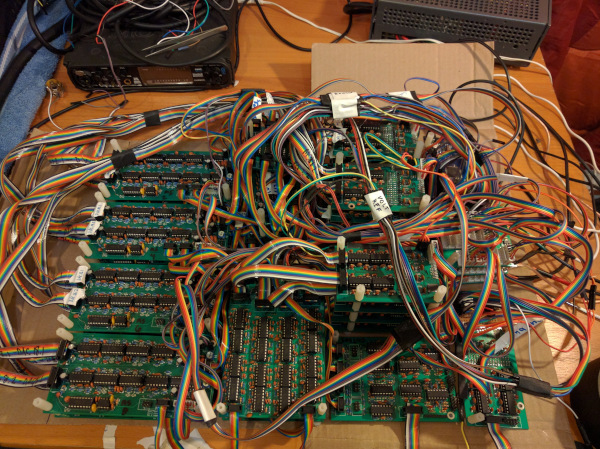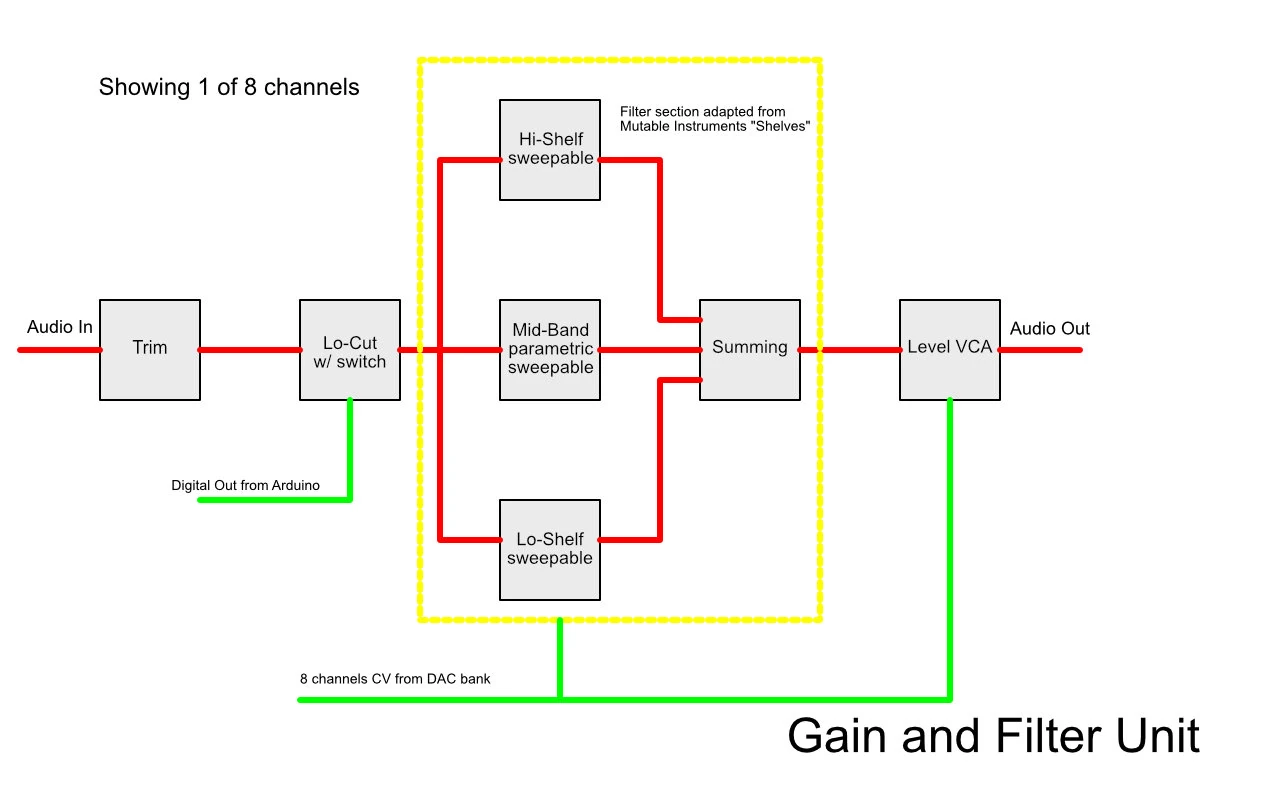Feedback Instrument v02

In 2015 I attended a David Tudor oriented conference at Wesleyan University. You Nakai and Michael Johnson were in the midst of some really wonderful work matching Tudor’s paper archives at the Getty with his unlabeled instruments at Wesleyan. One of the most fascinating narratives to emerge from their work is that (unsurprisingly) Tudor didn’t start out as an electronics expert. In fact, some of his early instruments/works were based on misunderstandings of schematics pulled for Popular Science and the likes.
That really struck a chord with me. Everything I’d built up to that point was extremely simple and mostly copied from schematics I found online. In other words I wasn’t really designing much.

instrument in process
Around the same time I did a tour of Europe. Hauling around 100lbs of gear over historic cobblestone streets led me start scheming about an easier way.
Unfortunately, there are no small format mixers (that I could find) that had the things I wanted. I thought about getting something and modding it, but at some point it became clear that building from scratch would be the only way I could get what I wanted while also getting the reduction in weight I needed.
It took about five minutes to decide everything should be voltage controlled and driven by Max/MSP.
There were three main reasons for this:
1. Increased potential for interactivity. Whereas before I could map analysis of any audio input into a VCA in the feedback path, now I could map that analysis to any part of the filter or gain chain.
2. Ability to recall presets: One of the drawbacks of working with non linear feedback is that if you find a behavior that’s really amazing, well you better enjoy it because you will never find it again. I thought if everything was on CV I could just save that state and recall it whenever. It turned out to be a little more complicated than this, but the presets are still incredibly useful, especially on projects like R WE WHO R WE.
3. Separate interface from audio generation. This might be obvious for anyone who’s ever played any instrument, but the way you control it often determines some pretty fundamental characteristics of the music. In starting to sort out the interfaces for this (which will be a different topic) I realized how dramatic this was. To the extent that I think you could call each different interface it’s own composition. It determines the character of the piece, what’s possible, what’s not in a very fundamental way.
Design

The first thing to sort out was the voltage controlled filter section. After a few false starts I came across the Mutable Instruments Shelves schematics that Olivier Gillet was generous enough to post online. In addition to doing pretty much exactly what I needed, all the parts were easily obtainable and not too expensive. Sticking a gain stage at the top and an additional VCA at the end was arbitrary. The lo cut switch was basically copied from the Mackie 1604.

Where my old setup was six channels of feedback it made sense to make this eight. The multiplexing chips I use in the matrix were all eight channel and the cool audio 2164 is a quad vca so…
The next big issue became CV control. Eight CV ins per channel and eight channels….that’s a lot of CV. Again, I looked at lots of options including spi and filtered pwm. At the time, my coding skills weren’t up to the challenge of the spi stuff and from what I’ve seen I’m not sure the spi solutions would really be the best for this, but maybe I’ll try again at some point.
The filtered pwm had it’s own set of issues, particularly trying to find a balance between keeping the pwm out my signal path and maintaining a fairly snappy response.

awkward with the smd's and thru hole stuff
I landed on a combination of the pca9685 12 bit, 16 channel led drivers and the ltc2645 pwm dacs. The dacs are a little expensive at about $2 a channel and soldering the msop package took some practice, but I understood more or less how to do what I needed, they were fast enough, had decent resolution and were quiet so…..
From there I attached some simple offset and scaling. I could definitely tailor this to the needs of the filters better, but for now it works well enough.
From there I attached some simple offset and scaling. I could definitely tailor this to the needs of the filters better, but for now it works well enough.

I had already started prototyping some matrixing switches that I could control from the Arduino and landed on the inexpensive cd 4051 chips which give 1:8. Once I got the buffering sorted, these worked well. Can I hear the difference between this method and using the big rotary switches I was using before? I think so, but the digital control and low power consumption win over anything else I was considering. But, this is a module I could see myself coming back to down the road.

The VCAs and switches function pretty much as they did before. VCAs now are 2164s, but like before they’re controlled from the audio interface allowing for oscillator input as well as standard DC stuff, controlled via Max/MSP.
Instead of the hardware switches I’m using the dg802s, controlled via the Arduino. I use these same switches for my lo cuts.
Instead of the hardware switches I’m using the dg802s, controlled via the Arduino. I use these same switches for my lo cuts.

Certainly having digital control over everything encourages greater use of software than I had in the past. That will be a separate post itself, but for now I’m excited that with everything linked up to software there are vast number of ideas to try out before I have to think about building more hardware!

People often remark on my cheap plastic enclosures. Most instrument builders take some care with the visual appearence of their instrument, which especially makes sense if you want to sell it.
That's defnitely not the case here. Aesthetically I like being able to see all the connections. But more than that, it's lightweight and easy to work with. I can typically do what I need with a dremel and a stepped drill bit. Cheap and easy.
That's defnitely not the case here. Aesthetically I like being able to see all the connections. But more than that, it's lightweight and easy to work with. I can typically do what I need with a dremel and a stepped drill bit. Cheap and easy.
Interface
After a ton of experimentation with various midi and OSC controllers (including the Korg nano line, an array of novation products, Lemur and TouchOSC) I settled on the MIRA package for Max, along with two Ipad 2's that I purchased off ebay for ~$30/ea. I kept a Novation Launch Control (for output mixing) and a Keith McMillan k-board (for selecting pitch sets).

Mixer Interface layout
In order to minimize interuptions to flow state in performance I realized I had to minimize switching between screen layouts. Thus the use of two ipads and the controls squeezed tightly together in these images.

Analysis Matrix
Just some more pics...

why yes that is a cardboard patchbay

it got big before it got small

the intermediate version had knobs for each channel's output level along with global pan controls

eventually put those dacs on their own breakout boards, eventually started preferring smd solding to thru hole

completed intrument